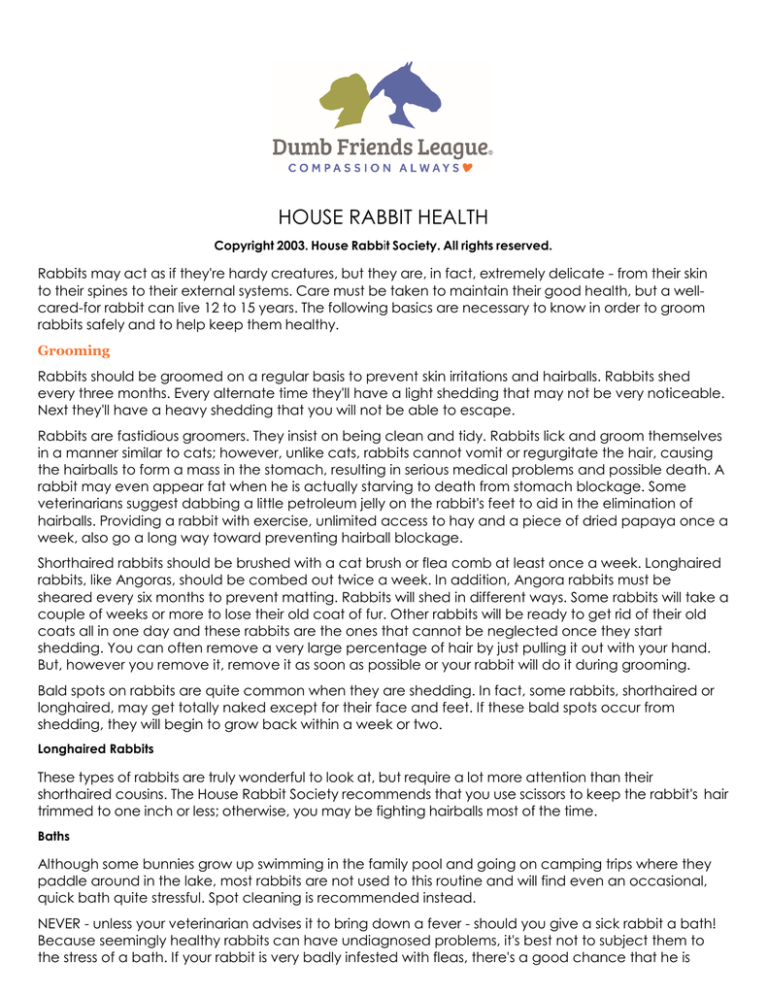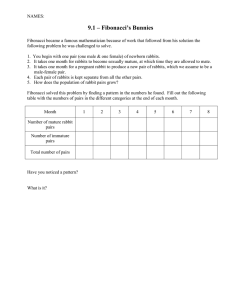
HOUSE RABBIT HEALTH
Copyright 2003. House Rabbit Society. All rights reserved.
Rabbits may act as if they're hardy creatures, but they are, in fact, extremely delicate - from their skin
to their spines to their external systems. Care must be taken to maintain their good health, but a wellcared-for rabbit can live 12 to 15 years. The following basics are necessary to know in order to groom
rabbits safely and to help keep them healthy.
Grooming
Rabbits should be groomed on a regular basis to prevent skin irritations and hairballs. Rabbits shed
every three months. Every alternate time they'll have a light shedding that may not be very noticeable.
Next they'll have a heavy shedding that you will not be able to escape.
Rabbits are fastidious groomers. They insist on being clean and tidy. Rabbits lick and groom themselves
in a manner similar to cats; however, unlike cats, rabbits cannot vomit or regurgitate the hair, causing
the hairballs to form a mass in the stomach, resulting in serious medical problems and possible death. A
rabbit may even appear fat when he is actually starving to death from stomach blockage. Some
veterinarians suggest dabbing a little petroleum jelly on the rabbit's feet to aid in the elimination of
hairballs. Providing a rabbit with exercise, unlimited access to hay and a piece of dried papaya once a
week, also go a long way toward preventing hairball blockage.
Shorthaired rabbits should be brushed with a cat brush or flea comb at least once a week. Longhaired
rabbits, like Angoras, should be combed out twice a week. In addition, Angora rabbits must be
sheared every six months to prevent matting. Rabbits will shed in different ways. Some rabbits will take a
couple of weeks or more to lose their old coat of fur. Other rabbits will be ready to get rid of their old
coats all in one day and these rabbits are the ones that cannot be neglected once they start
shedding. You can often remove a very large percentage of hair by just pulling it out with your hand.
But, however you remove it, remove it as soon as possible or your rabbit will do it during grooming.
Bald spots on rabbits are quite common when they are shedding. In fact, some rabbits, shorthaired or
longhaired, may get totally naked except for their face and feet. If these bald spots occur from
shedding, they will begin to grow back within a week or two.
Longhaired Rabbits
These types of rabbits are truly wonderful to look at, but require a lot more attention than their
shorthaired cousins. The House Rabbit Society recommends that you use scissors to keep the rabbit's hair
trimmed to one inch or less; otherwise, you may be fighting hairballs most of the time.
Baths
Although some bunnies grow up swimming in the family pool and going on camping trips where they
paddle around in the lake, most rabbits are not used to this routine and will find even an occasional,
quick bath quite stressful. Spot cleaning is recommended instead.
NEVER - unless your veterinarian advises it to bring down a fever - should you give a sick rabbit a bath!
Because seemingly healthy rabbits can have undiagnosed problems, it's best not to subject them to
the stress of a bath. If your rabbit is very badly infested with fleas, there's a good chance that he is
already compromised and may go into shock when bathed. Also, a thoroughly wet rabbit takes a very
long time to dry, so spot cleaning the dirty area is better than an over-all bath. Normal rabbit body
temperature is 102 degrees Fahrenheit and since they are subject to heat stress, use a warm dryer, not
hot.
If soap is needed during a spot cleaning, use a mild cat shampoo. Take care that the rabbit does not
become chilled, shocked or stressed during or after the cleaning.
Mats
Rabbit skin is delicate and highly susceptible to cuts, so mats should not be cut off with scissors. Instead,
use a mat splitter or mat rake to take the mass apart. Remember that bunny fur usually requires a finer
blade than most cats and dogs.
Skin
Scratchy, flaky skin with bald patches is usually a symptom of skin mites or an allergic reaction to fleas.
Cat flea powder clears up either condition. A veterinarian should be consulted for other skin irritations.
Feet
House rabbits who spend all of their time in homes with carpeting and linoleum periodically need to
have their toenails trimmed, in the same way as dogs and cats. If excessive digging or scratching is a
problem, then a large box of hay, shredded newspaper or straw, where bunny can pursue these
activities, may help. If the padding (fur) on the feet is worn down, exposing inflamed or callused skin,
then soft dry resting pads and rugs should be provided. Exposed skin that becomes urine burned or
broken is very likely to infect. Take extra care that rugs and litterboxes are kept clean and dry.
Because of risk of infection, declawing is definitely NOT recommended for rabbits!
Incontinence
A rabbit with a urinary infection or a disabled older rabbit may not be able to project urine away from
the body. The result may be saturated fur around the hindquarters. For milder cases, shave the areas
that get wet so the skin can dry (remember, rabbit fur takes a long time to dry), rinse the affected areas
daily and follow up with a dusting of baby powder or corn starch. For more infirm cases, disposable
baby diapers turned backwards so the tabs are up, do wonders for keeping the moisture away from
the skin. (Huggies Step 2 work well for an eight-pound rabbit.)
Ears
It's important to check your bunny's ears regularly. Ear wax can be lifted out with a cotton swab if
you're careful not to push on wax in the canal, or you can try a mild ear cleaner containing
Chlorhexadine, such as Nolvasan Otic. For ear mite infestation, apply a topical medication, such as
Mitox. Your veterinarian may also prescribe Ivermectin.
Teeth
Rabbits' teeth grow continuously and must be checked to ensure that they are wearing down properly.
While you're brushing your rabbit or clipping his nails, also look at his teeth to make sure there isn't a
problem. Bunnies with straight teeth will keep them worn down with everyday gnawing and chewing
on things like wood, untreated wicker and hard bread crusts. Buns with malocclusions, or crooked
teeth, will need to have their teeth kept trimmed with guillotine-type clippers. If this occurs and is left
untreated, the rabbit will not be able to eat and could starve to death. Your veterinarian can show you
how to clip a rabbit's teeth or they can clip them for you.
Nails
Rabbits' nails can grow to be very long and sharp, which is uncomfortable for the rabbit and why they
must be clipped regularly. Pedicures may be given with cat nail clippers. If the rabbit has light- colored
nails, they are very easy to trim. You can see the blood inside the nail and you clip just before that point.
It is more difficult to see where dark-colored nails should be clipped, but it is still visible.
Check your rabbit's nails every six to eight weeks.
People are often afraid to clip nails for fear that they will cause the rabbit to bleed. As with dogs and
cats, you can purchase a product called Kwik Stop to keep on hand for this problem. Some rabbit
owners find that simply holding pressure with a cotton ball works just as well. Your veterinarian will also
clip nails for you.
Rabbits enjoy burrowing and digging. Both of these activities help to naturally file down the nails. Also,
consider using non-toxic glue to adhere pieces of medium-grit sandpaper to heavy cardboard, giving
your rabbit an inevitable nail file.
Eyes
Watery eyes or eye discharge needs to be diagnosed by a veterinarian. In addition to any medications
or eye drops, the cheek needs to be kept dry and clean, so the area will not become chafed or the fur
peel off. Clean tissues will absorb mild wetness. Ophthalmic saline solution, which is what people use
with their contacts, carefully poured onto the cheek will crystallize the tears so that they can be
removed with a clean flea comb. A touch of prescription anesthetic powder on a finger can be
applied to the area if there are painful lesions.
Fleas
Flea collars should never be put on a rabbit. They are poisonous to all rabbits. If fleas are seen, an herbal
flea powder for cats may be used. Cat flea products are generally safe for rabbits with fleas, but it's
better to stick with powders and sprays. Carbaryl is the ingredient preferred by the House Rabbit
Society's veterinary advisors. One must be hesitant to treat rabbits' fleas aggressively because the cure
can be more stressful than the infestation, so flea baths and dips are not recommended.
A flea comb is a non-toxic device, which takes more patience, but is both physically and
psychologically rewarding. Most rabbits learn to love the attention of being flea combed, and it can be
used as a supplement to or as your main flea-control program. If you want to control fleas in the
environment with sprays or a flea bomb, do only one room at a time and keep your rabbits out of that
room for at least 24 hours.
Common Medical Concerns Among House Rabbits
Red Urine
Rabbits' urine varies in color from clear to yellow to brown to bright red. This is usually not a cause for
alarm unless there are additional signs, such as sitting and straining to urinate, loss of appetite or
temperature. When you see red urine, don't panic. Just keep your eyes open for other signs that might
indicate a problem. If in doubt, you can have your veterinarian test to see whether there is blood in the
urine.
Amoxicillin Danger
Never let a veterinarian give your rabbit amoxicillin. It is a pink liquid antibiotic that smells like bubble
gum. Amoxicillin is very dangerous for rabbits, and has killed many more than it has helped. Any
penicillin-based drug can be dangerous for your rabbit, so try to find a veterinarian who is
knowledgeable about rabbit-safe antibiotics and who is familiar with safer drugs, such as
Chloramphenicol, Tetracycline, sulfa-drugs based like Septra or TMS, or enrofloxins, such as Baytril or
Cipro.
Cedar and Pine Shavings
These are very bad for your rabbit and other small pets, such as gerbils, hamsters, guinea pigs, mice
and rats. The aromatic hydrocarbons produced from softwood beddings can cause both respiratory
and liver damage in rabbits and other small animals. Use organic litter in the litterbox and put
newspaper in the cage tray.
Surgeries
Make sure your rabbit is in good health prior to elective surgeries. Food and water should not be
removed from a rabbit the evening before surgery! Any change in diet can upset a rabbit's sensitive
digestive tract and cause problems in post-operative recovery. One of the reasons some veterinarians
recommend removing animals' food before surgery is the possibility that they may vomit. Rabbits
cannot throw up, thus this is not a concern. Additionally, some veterinarians are concerned about
spaying rabbits with a full cecum. Unfortunately, the cecum would take 3-4 days of fasting to empty
out, and by that time, the rabbit would be dead. So please, do not fast your rabbit before surgery! After
surgery, make sure the rabbit's cage is clean, and check her incision site daily for swelling or discharge.
Do everything you can to get your rabbit to eat again as soon as possible after returning home. To
coax him to eat again, you may have to offer a variety of treats, including his regular pellets and hay. If
your rabbit has not eaten for 48 hours after surgery, consult your veterinarian.
Bacterial Infections
The first indication of an infection may be a runny nose or eye, sometimes a high temperature,
sometimes a rattling sound from the lungs or (rarely) a coughing sound. It is important to see your
veterinarian as soon as the first symptoms of any infection appear, as they are more easily cured when
caught in the early stages. The bacteria you may hear the most about is called Pasteurella. This used to
be a major problem, but with the newer antibiotics, this bacteria can often be eliminated.
And, if not totally eliminated, it can be controlled with the use of long-term antibiotics. Most of the
symptoms described are quite common for many types of bacteria, so it is important to have your
veterinarian do a culture to determine exactly what is being treated.
Digestive Problems
The following symptoms require that you see your veterinarian immediately. Diarrhea - it can be fatal.
Rabbits have various kinds of diarrhea, if it's runny, messy and smelly, it's easy to identify. A more subtle
form of diarrhea, which does not require the urgency of runny diarrhea, is when the droppings appear
to be normal, but "squash" when you touch or sweep them up. You may also see "clumpy" diarrhea. This
will be the consistency of silly putty, with normal round droppings mixed in. Diarrhea usually requires
antibiotics from your veterinarian. Other signs to watch for are loud tummy growling, small and/or
misshapen droppings or no droppings at all. See your veterinarian if any of these symptoms appear.
(Veterinarians often misdiagnose this problem as being a hairball.)
Spay/Neuter
If you have an intact house rabbit at home and are concerned about dangers involving spay or neuter
surgeries, you should know that The House Rabbit Society has had more than 1,000 rabbits spayed or
neutered with only approximately .13 mortality due to anesthesia. On the other hand, the risk of
reproductive cancer, which is fatal, for an unspayed female rabbit stands at approximately 853, which
makes spaying an absolute necessity. For male rabbits, the benefits are primarily behavioral, such as
eliminating spraying and hormone-related aggression, but are just as important. A knowledgeable
rabbit veterinarian can perform a spay or neuter surgery with very little risk to a healthy rabbit.



